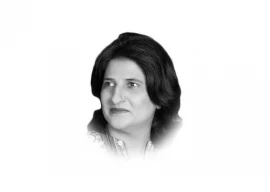
“The population growth of Rohingya Muslims is 10 times higher than that of the Rakhine [Buddhists],” said Win Myaing, a spokesperson for Burma’s western Rakhine State, where most of the stateless Rohingya live. That was in 2013, when the state passed a controversial two-child limit law that applied only to Muslims.
Just last month, an administrator of a “Muslim-free” village outside Yangon told The New York Times, “[Rohingya] are not welcome here because they are violent and they multiply like crazy, with so many wives and children.” The motto of Burma’s immigration ministry is, “The Earth will not swallow a race to extinction, but another [race] will.”
Myanmar beauty queen dethroned 'after posting Rohingya video'
According to a study published in 2013, there was a net outflow of Rohingya from Burma after 1950 before the unprecedented exodus of the last three months. Moreover, Burma’s Muslim population has been stable at around 4 per cent since the 1980s, according to the country’s own census.
This perception that Muslim communities are overpopulated stems from anywhere there is a Muslim immigrant or minority community ranging from India to Western Europe.
Hindu nationalists exhibit tension about Muslim population growth; the proportion of Muslims in India grew about 0.8 per cent between 2001 and 2011, to 14.2 per cent. “If this remains the situation, one should forget about their existence in one’s own country by 2025,” said the leader of a major Hindu nationalist organization last year.
But the fertility gap between Muslims and Hindus in India is narrowing fast, and the greatest birthrate disparities are between states, not religions: Hindu women in the very poor state of Bihar have about two more children each than Muslim women in more developed Andhra Pradesh.
The myth of Muslim overpopulation is worldwide, and more people worry about numbers each day. However, the claim in itself is "demonstrably false" as is shown in the case of Burma. It’s true that the global Muslim population is growing, and fast. But it’s not growing at the same speed across regions. And the trope seems to have the most power not where Muslim populations are actually growing the fastest—like sub-Saharan Africa—but in places where they are culturally distinct minorities.
There’s nothing inherent in Islam to link it to higher fertility—in fact, it’s not a particularly natalist, or pro-birth, religion. Eight of the nine classic schools of Islamic law permit contraception. Many Muslim states, including Pakistan, have supported family planning. The growth of the global Muslim population was, according to a 2011 Pew Center report, due to both a “youth bulge”—an unusually high number of young Muslim people, which peaked around 2000— and a higher overall fertility rate for Muslim women as a group.
Pakistan urges Myanmar to ensure safety of persecuted Rohingya Muslims
The claim about Muslim overpopulation falls apart in fascinating ways when examined more closely. The fastest fertility drop in modern history happened in the Islamic theocracy of Iran. In 1950, Iranian women had about seven children each; today they have about 1.68, fewer than Americans.
In the world’s largest Muslim-majority country, Indonesia, fertility rates dropped between the 1960s and the 1990s, from about 5.6 children per woman to 2.3, as the Suharto dictatorship instituted a vigorous, centralised family planning program and made improvements to girls’ education
But it’s unlikely that these, or any, facts about Muslim demographics will change minds anywhere. In a demographics report, Nicholas Eberstadt and Apoorva Shah, researchers at the American Enterprise Institute, write, “There remains a widely perceived notion—still commonly held within intellectual, academic, and policy circles in the West and elsewhere—that ‘Muslim’ societies are especially resistant to embarking upon the path of demographic and familial change that has transformed population profiles in Europe, North America, and other ‘more developed’ areas.”












1736508423-0/Express-Tribune---News-Desk-(9)1736508423-0-270x192.webp)










COMMENTS (1)
Comments are moderated and generally will be posted if they are on-topic and not abusive.
For more information, please see our Comments FAQ